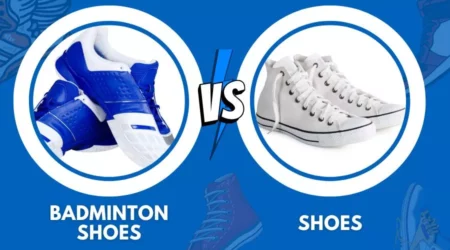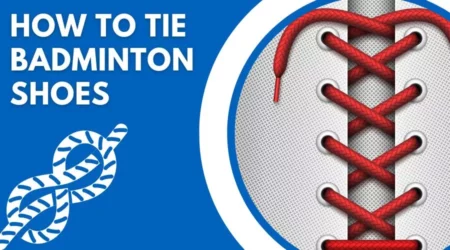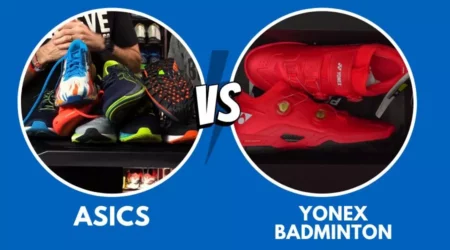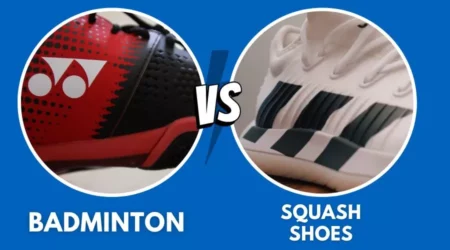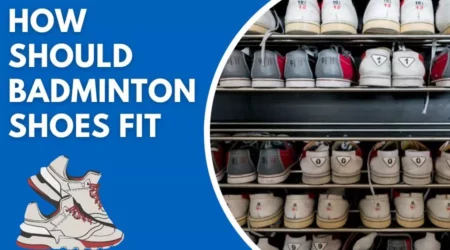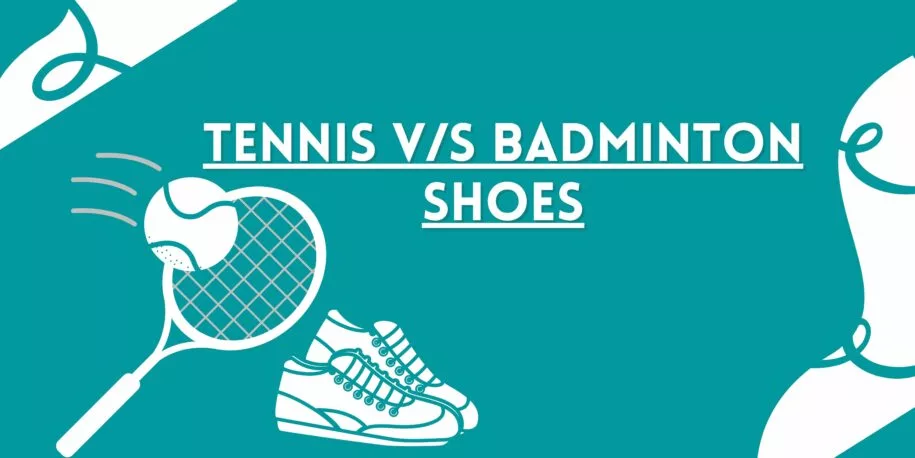
We will explore the benefits of wearing Tennis VS Badminton Shoes
In both cases, it is important to consider your goals as a player, as well as your skill level.
The main difference between Tennis and Badminton Shoes is that Tennis shoes have a very thick sole with enhanced support and stability while Badminton shoes have thinner soles which helps the player to move quickly on their feet.
Tennis shoes are mainly used for playing on hard courts while Badminton shoes can be used on any type of court.
The primary consideration for beginners who are just hard court tennis shoes starting out should be comfort and stability.
For those players with more advanced skills or higher levels of competition, shoe choice may become a matter of preference between two equally effective options.
If you want to become profession badminton player and looking for best badminton shoes more maneuverability when moving around the court, choose an athletic shoe with softer soles like those of badminton shoes.
These shoes will give you the ability to pivot quickly when smashing or driving shots downcourt.
Tennis v/s Badminton Shoes: An Overview Of The Difference
- Less padding Tennis shoes are specifically designed for use on tennis courts. It is built with a variety of features to cater to the needs of those who play tennis as a sport. In contrast, badminton shoes are created to address the specific needs of an individual who participates in the sport of badminton.
- Tennis shoes have a thick sole to protect your feet against abrasions while playing on tennis courts
- Tennis shoes are built with speed lacing systems for quick and convenient tightening or loosening of the shoes- Tennis shoes are designed with non-marking soles which make them ideal for use on tennis courts
- Badminton shoes, on the other hand, are created to address the specific needs of an individual who participates in badminton. Some of these features include a wider toe box and slip-on laces which allow for better lateral movement on shuttle courts
- Badminton shoes are made with thinner soles which make them more suitable for use on badminton courts when compared to tennis shoes
- Badminton shoes also come in different arch heights which cater to specific needs of an individual’s game style. The lack of these features in Tennis shoes.
Differences Between Tennis Shoes And Badminton Shoes
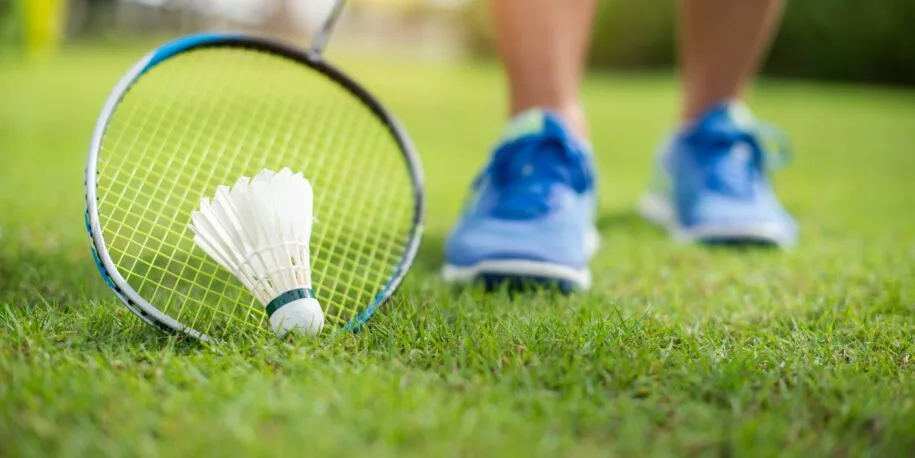
Tennis vs Badminton Shoes Design
The design of a shoe is different in the way that it will support you while playing. In badminton, you’ll be running back and forth to cover your opponent’s shots, or chasing down your own drop shots. A tennis shoe has been designed with a reasonable amount of support for lateral movement, but won’t have the grip of a badminton shoe.
Type Of Soles Of Badminton & Tennis Shoes
The type of sole on the shoe will impact how much grip you get while playing badminton. The soles of a tennis shoe will generally be thinner and not made to resist wear and tear from court surfaces. On the other hand, a badminton shoe is designed with extra rubber related to the amount of wear and tear it may normally receive from the court surface.
Quality material Of Tennis and Badminton Shoes
The quality of a shoe is different in how long it will last you while playing badminton. A tennis shoe has been designed with a low-quality leather to keep costs down, and will often have parts of the upper made from mesh to keep your feet cool during hot games. On the other hand, a badminton shoe will be made with higher-quality leather, and parts of the upper may be added to ensure that your feet stay as cool as possible.
Badminton vs Tennis Design sole
Just like in tennis shoes, the design of the sole is different between these two types of shoes. The idea behind a badminton shoe is to give your foot maximum grip on the court surface. Look for smaller “studs” or “cleats” on the bottom of a badminton shoe like this Adidas Duramo Slide II . The more studs, the better. Having more studs also means you have less chance of slipping when playing!
Tennis Shoes vs Badminton Shoes Grip patterns
The grip patterns on the bottom of a shoe are different in that type of court you’re playing badminton on. If you’ll be playing on wood, or high-quality carpet, then a tennis shoe with a regular grip pattern will work just fine. However, if you play regularly on a lower quality surface like cement or asphalt -and you play in hot weather- you should consider a badminton shoe with an aggressive grip pattern for extra traction and stability.
Badminton & Tennis Shoes Weight
The weight of a shoe is different because if you’re playing tennis, your main concern will be lateral movement and stability. A badminton shoe is heavier to help resist wear and tear on the court, but isn’t great for lateral movement.
Price Of Badminton vs Tennis Shoes
If you play mostly on low-quality courts at the local park, then tennis shoes will work fine. However, if you play frequently on high-quality courts or in hot weather and humid climates, then a badminton shoe will be the right choice for you. Thus, badminton shoes tend to be more expensive than tennis shoes.
Flexibility Of Tennis Shoes vs Badminton
The flexibility of a shoe is different in how nimble you are on your feet. A badminton shoe will have more support, but will lack the flexibility to do quick turns or moves. Tennis shoes are flexible enough to allow you to quickly move from side-to-side, and pivot when hitting the ball.
Tennis and Badminton Shoes Cushioning
The cushioning of a shoe is different in how much shock your legs and feet will experience from the court surface. Tennis shoes have been designed to reduce impact from jumping, but badminton shoes will have extra padding for this purpose as well as reducing wear and tear from walking on the court.
Style / Appearance Of Both Shoes
In terms of style, tennis shoes have been designed in the image of actual tennis shoes. The colors are loud and eye-catching, and can be found in almost any color combination you prefer. On the other hand, badminton shoes tend to be more “boring” because they aren’t worn for views but to do one specific job well.
Difference Between Tennis And Badminton Shoes Playstyle
The playstyle required for each game is different in what kind of shoe you need to wear, thus the shoes are designed differently. Tennis shoes will be lighter in weight, more flexible and have better lateral movement; whereas badminton shoes will be heavier, less flexible and with more grip for stability on court.
Durability Of Both Shoes
Because the point of a badminton shoe is to last longer on court, they have been designed to resist wearing down. Tennis shoes will have high-quality materials in their construction, but are overall made with less durable material because it’s expected for you to replace them when they wear out.
Can You Wear Tennis Shoes For Badminton?

Wearing badminton shoes are meant for use specifically on tennis courts.
It is designed to have a variety of support features that provide comfort while playing tennis.
This includes thick soles to protect you from abrasions and also speed-lacing systems so that you can quickly tighten or loosen your shoe without having to tie laces manually.
Many Tennis shoes also use abrasion-resistant materials for the outsole to protect the shoe against wear and tear that is mostly caused by movement across a tennis court.
If you try to use Tennis shoes for badminton, your foot will likely slide inside the shoe every time you move sideways. This is quite dangerous as it can cause injuries, especially when playing competitive matches.
Tennis shoes have a non-marking outsole so that the soles do not leave marks on the floor where you are playing tennis.
This feature makes using Tennis shoes for badminton highly impractical as the soles will leave marks on the shuttle court which will then have to be cleaned up after every match.
While there are many benefits of choosing Tennis shoes over other types of badminton shoes, do bear in mind that there are specific features that are designed for each type of sport for most slippery court surface.
Using the wrong shoe can cause you to have poor performance in your game.
Therefore, it is important to do some research before you choose which shoes are right for your needs.
What kind of shoes are best for badminton?
Badminton shoes are made for both indoor and outdoor use.
They tend to be light, with the ability to pivot well on fast stops and starts common in matches.
Most badminton shoes have rubber soles that provide traction for quick changes of direction on hardwood courts.
High-end shoes are usually sold with removable spikes that allow the wearer to change the amount of traction for different playing surfaces.
There are many make and types of badminton shoes, you can choose any which you want to use it.
Final Thoughts On Tennis V/S Badminton shoe
Wear badminton shoes are best for those who play on hard surfaces.
Badminton players should buy badminton shoes to help with their game performance and comfort.
Overall, tennis shoes and badminton shoes are different in the following ways:
The grip you’ll get from your shoe, the quality of material and how long it will last you,
The design of sole and grip pattern for your court surface, weight and flexibility to suit your playing style, cushioning for shock absorption and style / appearance.
FAQS
Which is harder badminton or tennis?
At the highest level badminton is a much harder sport. In tennis you can get away with being one speed all the time, but in badminton every shot has to have a different pace and different angle
How to pick the best shoes for your feet for badminton?
There are a number of things you have to keep in mind when shopping for badminton shoes. What surfaces will you be playing on most? If it’s hard courts, then hard-soled or stiff soles work best. For grass, a soft sole works better as this gives a little ‘give’ when landing from a skidding shot. Most players choose a soft sole for general use, but then change to hard soles for hard court tournaments.
What kind of racket do i need?
You’ll need a racket with a head size of about 80-90sq.cm., which is bigger than that of a tennis racket. A flexible frame with enough power to hit the shuttle, but not so stiff that it prevents you from playing aggressively. Generally, lighter rackets are better for casual players as they generate less fatigue on the wrist and arm over time.
Can badminton shoes be used for tennis?
Yes, badminton shoes can be used for tennis. However, they are not ideal, as they do not provide the same level of support and stability as tennis shoes. Additionally, the soles of badminton shoes are not as durable as those of tennis shoes, so they may wear down quickly if used frequently on a tennis court
Is tennis shoes different from badminton shoes?
There are some differences between tennis shoes and badminton shoes. For starters, tennis shoes tend to be more supportive and stable, providing better traction on the court and greater protection for the feet. In addition, the soles of tennis shoes are typically made from more durable materials than those of badminton shoes, which can wear down quickly if used frequently on a hard court surface. However, both types of shoes can be used for either sport. It really just depends on the player’s preference.
Are badminton and table tennis shoes the same?
Badminton and table tennis shoes are similar in that they are both designed to provide comfort and support during quick, lateral movements. However, there are some key differences between the two. Table tennis shoes have softer soles to provide better grip on the smooth, indoor surfaces often used for playing table tennis. Badminton shoes generally have harder

